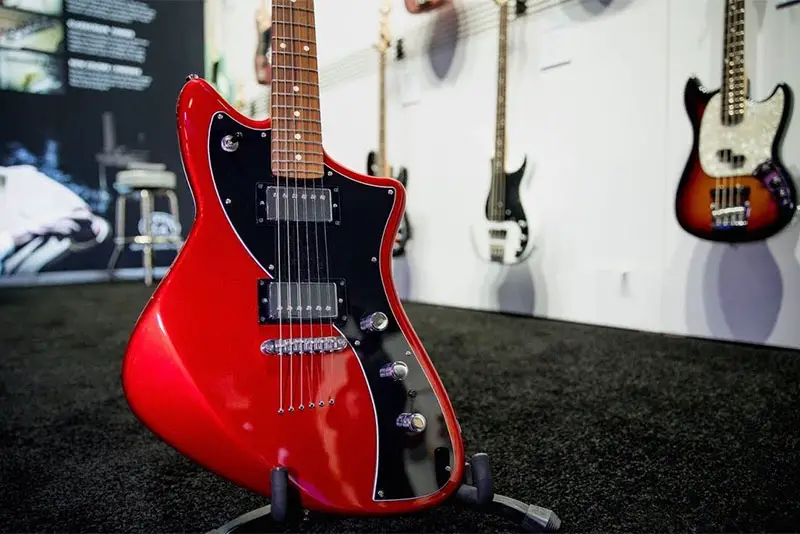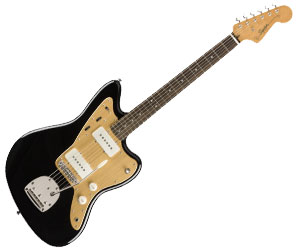Today we`re going to put two classic guitar models through the ringer to see which of the two is superior in a variety of departments including tone, features, reliabilty playabillity and overall presence. Presenting The Squier Vintage Modified Jaguar and the Squier Classic Vibe 60s Jazzmaster.
Fender Jaguar vs Jazzmaster
The first impression when you see either of these guitars is that there are extremely stylish and well finished. From a visual standpoint they are stunning and Squier did a fantastic job in capturing the essence of the original Fender versions of each of these guitars.
Squier also ensured that these instruments were iconic and unique in there own individual way and both were crammed with features that give you endless sonic possibilities. Although the two guitars have a similar shape and feel they do differ in a few areas.
If you were thinking of purchasing one of these guitars and were struggling to choose between the two, hopefully after reading this review you will be able to make a better and more informed decision regarding the two.
The initial aesthetics are definitely striking to say the least. It`s a beautiful surf green, reminiscent of the 60`s when the original was released and the colour blends well with the white scratch plate and nickel plated hardware. So at a glance it is definitely visually appealing. But what about when we scratch beneath the surface?Looking at the specifications:
- Basswood body
- Maple neck with a c shape neck profile and 22-medium jumbo frets
- Rosewood fingerboard
- Duncan Designed single coil pickups
- Non locking floating vibrato
- 24″ scale
- Urethane finish
Running through the specs quickly:
- The basswood body is a softwood so it will benefit users who prefer a lightweight guitar. It is also a sonically balanced tonal wood that breaks through in the mid-range to give a little kick.
- C shaped neck profile will give playability the whole length of the neck while the maple will suit the treble giving a bright and shiny tone. The jumbo frets will also make fretting the neck easier.
- Rosewood will give the guitar a warm tone and help with resonance and sustain.
- Single coil pick ups are bright and chimey.
- Non-locking floating vibrato will allow players to recreate those classic wobbly bends.
- 24″ is quite a short scale which should increase the comfort of the guitar.
- Controls on this guitar provides ample tonal versatility and the ability to switch between the lead circuit and rhythm circuit will give players the impression they are playing two guitars.
What are customers saying?
Owners were particularly impressed with the fact that the quality is so good for its relatively inexpensive price when you could be paying much more for a Fender Jaguar. The quality of the sound was not impacted by the lower end price range as customers were also very happy with the sound saying it played well with different styles.
The more negative reviews seemed to revolve around issues with the set up. A few customers had problems with the action and needed to make truss rod adjustments while others needed to buy new bridges to alleviate buzzing and ringing noises.
- Lightweight and a short scale make this a comfortable and playable guitar
- The flexible control system and the vibrato offers players a wide range of tonal possibilities
- It`s an aesthetically pleasing guitar
- Could be some issues with playibility out of the box
First impressions are that this is a gorgeously well crafted piece of engineering. Everything about the guitar seems perfectly balanced and symmetry is well executed.
The sunburst finish and tortoise pickgaurd are also a killer combination. Leaving appearance aside for a moment and getting down to business the specs are as follows:
Specifications:
- Poplar body
- Maple neck with a c-shaped neck profile and 21 medium jumbo frets
- Laurel fingerboard
- Fender designed Alnico single coil pickups
- Non locking floating vibrato
- 25.5″ scale
- Urethane finish
Running through the specs quickly:
- The poplar body is a fantastic tonal wood which provides a balanced and soft tonality
- The maple neck will provide the necessary brightness while the c shaped profile offers playability
- Laurel is virtually indistinguishable from rosewood for a fingerboard and should share tonal qualities
- Single coil pickups will be bright but as the pickup is slightly wider it should give a fuller and warmer tone
- Vibrato will afford players the opportunity to experiment with some vintage styled bends
- Much like the Jaguar the controls on the Jazzmaster will give players plenty in terms of tonal variation
What are people saying?
Going through a number of verified reviews we concluded that the sound was great and very versatile and balanced but a few were a little less enthusiastic about the set up and the fact that it was a little bit heavier than average.
The complaints were about the bridge causing buzzing sounds, a problem shared between the Jaguar and the Jazzmaster. But just like the Jaguar as this is a well priced guitar, quality control problems can be expected.
- Aesthetically impressive
- A wide array of tonal variations are available thanks to the control system
- Fantastic sound
- Potential issues with set up
Verdict
Without a doubt either of these beauties would be a fine addition to anyone`s collection. They each offer bang for your buck, amazing sound and an abundance of tonal possibilities to experiment with. Coupled with that the fact that these are two very attractive guitars, you almost have the full package and while this may be the case there are a few niggling issues.
The general consensus is that these are two quality sounding guitars that have the tonal capabilities of covering a wide range of genres and styles. Its a pity then to see that poor build quality and a lack of attention to detail on a few models has led to some negative feedback on these otherwise awesome guitars. Nevertheless, Its important to consider the value for money that you get here in terms of sound and tonal variation.So,the final question.Which is the better of the two?
Choosing the better guitar here is subjective as its a matter personal preference. Taste, playing style and needs should all be considered before making a decision. The Jazzmaster has a fuller and warmer tone and because of its larger pickups it also has a higher output. As a result it handles distorted and overdriven tones well.
So if you`re your more keen on warmer and heavier tone then the Jazzmaster might suit. In contrast the Jaguar will provide brighter and more sparkly tone which would be perfect for a player who needs their sound to cut through.
In terms of performance they are almost neck in neck. Based on the fact that the Jazzmaster offers a little more in terms of style and because it is a little more tonally balanced (warm tonal wood and bright single coil combination) I think the Jazzmaster just about steals a win here. Another point in its favour was that it had less critical reviews.
Are Jazzmaster and Jaguar bodies the same?
Though they are similar in shape and structure they are not exactly the same. The Squier Jaguar has a basswood body which is light softwood while the Squier Jazzmaster has a poplar body which is heavier and considered to be a hardwood.
Another difference exists with regards to the pickups. They pickups on the Jazzmaster are bigger and the final difference is that the Jaguar has a panel with sliders for changing between pickups while the Jazzmaster has a 3 way toggle switch.
What do the switches on a Jazzmaster do?
The electronic configuration is one of the key distinctions between these guitars and others of a similar style or price range. The controls for this configuration feature 2 sliders at the top of the Jazzmaster. These are the controls for two circuits.
First, the rhythm which is the neck pickup and second, the lead which can be either the neck or bridge pickup or a combination of the two. Its important to note that when the rhythm slide is engaged, the bridge pickup and the toggle switch become non functional. Alongside the sliders previously mentioned are two rollers.
The one on the far left is for Rhythm tone and the other for volume. At the bottom of the Jazzmaster, starting on the loft are the master tone knob followed by the master volume knob and finally the 3 way toggle switch to choose between pickups.
What do the switches on a Fender Jaguar do?
The configuration for the Jaguar is much the same only that in place of the 3 way toggle switch there is a small silver panel which is used for the lead circuit.This silver panel houses three sliders.
The slider on the right activates the rhythm pickup (neck pickup) while the slider in the centre activates the lead pickup (bridge pickup). The final slider on the left allows you to cut the mid-range frequency across all the pickups.







Leave a Reply